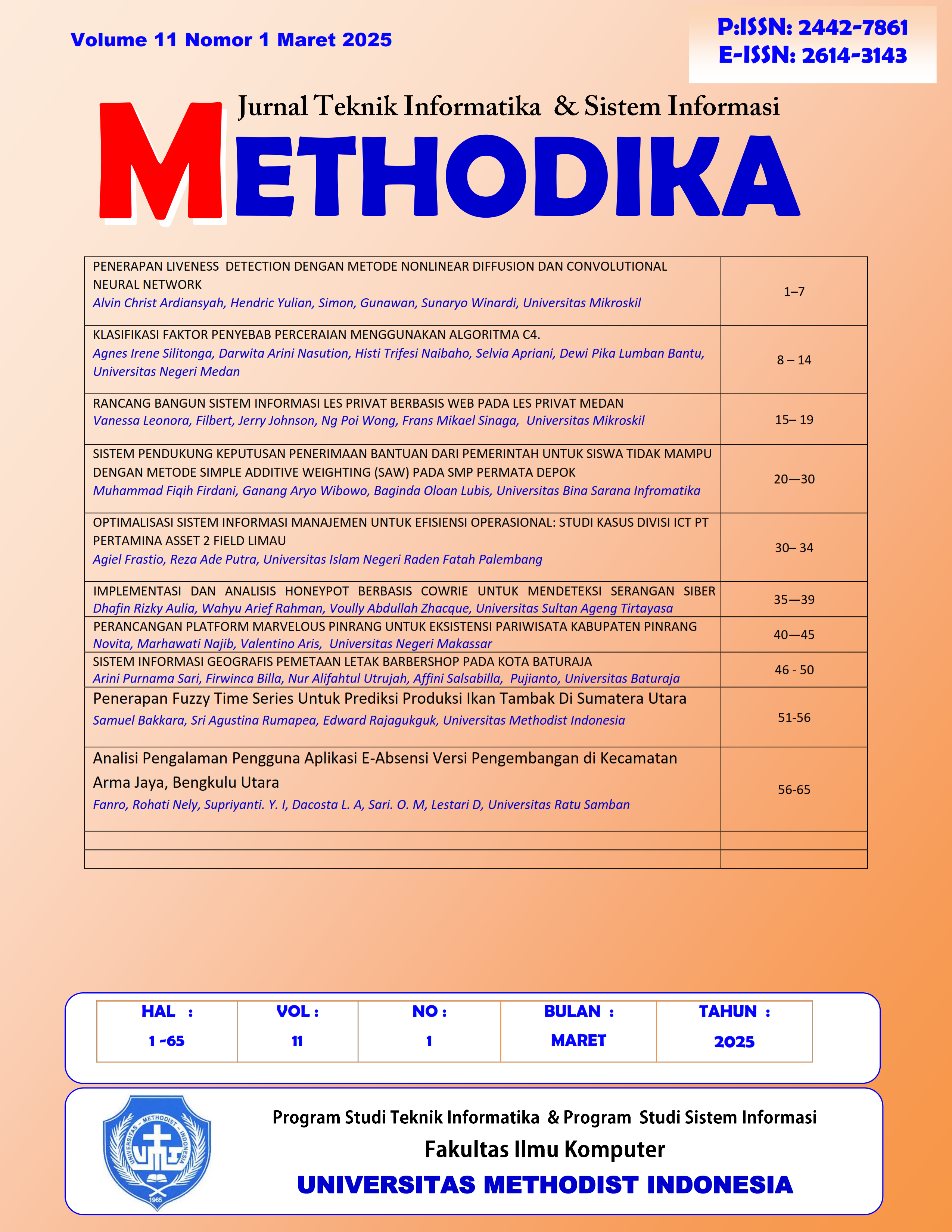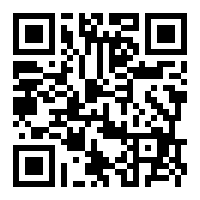PENERAPAN LIVENESS DETECTION DENGAN METODE NONLINEAR DIFFUSION DAN CONVOLUTIONAL NEURAL NETWORK
Keywords:
liveness_detection, nonlinear_diffusion, spoofing, facial_recognitionAbstract
With the advancement of increasingly affordable camera technology and the ease of image capture processes, facial recognition has become the biometric authentication method most vulnerable to spoofing attacks. This vulnerability significantly undermines the data integrity and reliability of facial recognition-based attendance systems. Therefore, a liveness detection method is required to help mitigate these spoofing attacks. This study aims to enhance the reliability of existing attendance systems in the teacher and staff attendance application developed for Universitas Mikroskil. In this research, the reliability of the liveness detection system will be tested using a nonlinear diffusion algorithm and Convolutional Neural Network (CNN) against spoofing attacks, employing a confusion matrix method. Based on the conducted tests, the designed liveness detection system achieved an accuracy rate of 87.76%.
References
I. Chingovska, N. Erdogmus, A. Anjos, and S. Marcel, “Face recognition systems under spoofing attacks,” in Face Recognition Across the Imaging Spectrum, Springer International Publishing, 2016, pp. 165–194. doi: 10.1007/978-3-319-28501-6_8.
G. Pan, Z. Wu, and L. Su, ‘Liveness Detection for Face Recognition’, Recent Advances in Face Recognition. InTech, Jun. 01, 2008. doi: 10.5772/6397.
E. A. Raheem, S. M. S. Ahmad, and W. A. W. Adnan, “Insight on face liveness detection: A systematic literature review,” 2019, Institute of Advanced Engineering and Science. doi: 10.11591/ijece.v9i6.pp5165-5175.
F. M. Chen, C. Wen, K. Xie, F. Q. Wen, G. Q. Sheng, and X. G. Tang, “Face liveness detection: Fusing colour texture feature and deep feature,” IET Biom, vol. 8, no. 6, pp. 369–377, Nov. 2019, doi: 10.1049/iet-bmt.2018.5235.
T. Putra Agastiya (2023), “PENERAPAN
PENGENALAN WAJAH DENGAN ALGORITME MTCNN DAN FACENET PADA APLIKASI PRESENSI GURU DAN PEGAWAI.”, Undergraduate (S-1) thesis, Universitas Mikroskil. https://repository.mikroskil.ac.id/id/eprint/3273/
C. Yu, C. Yao, M. Pei, and Y. Jia, “Diffusion-based kernel matrix model for face liveness detection,” Image Vis Comput, vol. 89, pp. 88–94, Sep. 2019, doi: 10.1016/j.imavis.2019.06.009.
X. Liu, R. Lu and W. Liu, "Face liveness detection based on enhanced local binary patterns," 2017 Chinese Automation Congress (CAC), Jinan, China, 2017, pp. 6301-6305, doi: 10.1109/CAC.2017.8243913.
Institute of Electrical and Electronics Engineers, IEEE International Conference on Advances in Engineering and Technology Research 2014.08.01-02 Unnao, and ICAETR 2014.08.01-02 Unnao, International Conference on Advances in Engineering and Technology Research (ICAETR), 2014 1-2 Aug. 2014, Unnao, Kanpur, [Uttar Pradesh], India.
[9] W. Kim, S. Suh, and J. J. Han, “Face liveness detection from a single image via diffusion speed model,” IEEE Transactions on Image Processing, vol. 24, no. 8, pp. 2456–2465, Aug. 2015, doi: 10.1109/TIP.2015.2422574.
R. Koshy and A. Mahmood, “Optimizing deep CNN architectures for face liveness detection,” Entropy, vol. 21, no. 4, Apr. 2019, doi: 10.3390/e21040423.
J. Ralli, “PDE Based Image Diffusion and AOS,” 2012. [Online]. Available: www.jarnoralli.com
A. Alotaibi and A. Mahmood, “Deep face liveness detection based on nonlinear diffusion using convolution neural network,” Signal Image Video Process, vol. 11, no. 4, pp. 713–720, May 2017, doi: 10.1007/s11760-016-1014-2.
Sudeep, S.V.N.V.S., Venkata Kiran, S., Nandan, D., Kumar, S. (2021). An Overview of Biometrics and Face Spoofing Detection. In: Kumar, A., Mozar, S. (eds) ICCCE 2020. Lecture Notes in Electrical Engineering, vol 698. Springer, Singapore. doi : 10.1007/978-981-15-7961-5_82
DiWen, Hu Han, and Anil K. Jain. Face spoof detection with image distortion analysis. IEEE Transactions on Information Forensics and Security, 10(4):746–761, 2015. doi:10.1109/TIFS.2015.2400395
Y. Liu, A. Jourabloo and X. Liu, "Learning deep models for face anti-spoofing: Binary or auxiliary supervision", Proc. IEEE Comput. Vis. Pattern Recognit., pp. 389-398, Jun. 2018, doi 10.1109/CVPR.2018.00048
D. Timoshenko, K. Simonchik, V. Shutov, P. Zhelezneva and V. Grishkin, "Large Crowdcollected Facial Anti-Spoofing Dataset," 2019 Computer Science and Information Technologies (CSIT), Yerevan, Armenia, 2019, pp. 123-126, doi: 10.1109/CSITechnol.2019.8895208.
J. Weickert, B. M. T. H. Romeny and M. A. Viergever, "Efficient and reliable schemes for nonlinear diffusion filtering," in IEEE Transactions on Image Processing, vol. 7, no. 3, pp. 398-410, March 1998, doi: 10.1109/83.661190.
C. Szegedy, et al., "Inception-v4, Inception-ResNet and the Impact of Residual Connections on Learning," in Proceedings of the Thirty-First AAAI Conference on Artificial Intelligence (AAAI-17), 2017, pp. 4278-4284, doi : https://doi.org/10.1609/aaai.v31i1.11231
M. S. ANGGREANY, “Confusion Matrix”, Accessed: April 25, 2024. [Online]. Available: Jurnal METHODIKA, Vol. 11 No. 1 MARET 2025 P-ISSN : 2442-7861 E-ISSN : 2614-3143 https://socs.binus.ac.id/2020/11/01/confusion-matrix/
Bhandari Aniruddha, “Understanding & Interpreting Confusion Matrices for Machine Learning,”, Accessed: April 25, 2024. [Online]. Available: https://www.analyticsvidhya.com/blog/2020/04/confusion-matrix-machine-learning/
J. Brownlee, “What is a Confusion Matrix in Machine Learning,”, Accessed: April 25, 2024. [Online]. Available: https://machinelearningmastery.com/confusion-matrix-machine-learning/
Downloads
Published
How to Cite
Issue
Section
License
Copyright (c) 2025 Alvin Christ Ardiansyah, Hendric Yulian, Simon, Gunawan, Sunaryo Winardi

This work is licensed under a Creative Commons Attribution 4.0 International License.











